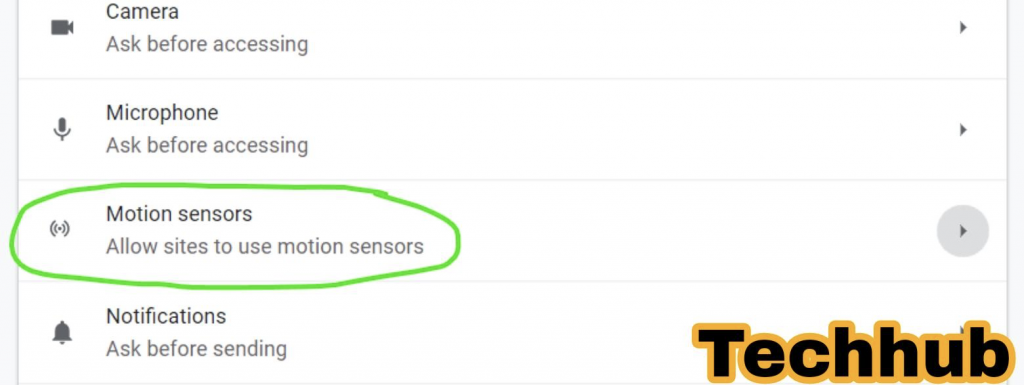The world’s most famous internet browser is Chrome, and it is regulated by a search engine giant which also controls 75% of web tracking. Google chrome is the most prominent desktop and mobile internet browser. It has taken over the market since its launch in 2008, with seventy percent of desktop operators opting for Chrome. Although Google at first didn’t want to be involved in the wars between diverse browsers, the company is now the winner.
The recent features allows you to customize your landing page with custom pictures or any of Chrome’s backgrounds. Even though this setting will boost your experience as a user on Chrome, there is a lot you should put in place to improve both your safety and security when browsing the Internet.
Should I block motion sensors in Chrome?
According to Zak Hoffman, Google’s digital ad earnings continue to rise, unlike Facebook, its counterpart, which has been affected a lot by Apple’s latest privacy regulations. The fact is, while Facebook operates as a lightning rod, the bigger threat to your privacy is Google. Zak educated us on how Facebook collects this information for itself, while Chrome is delighted to collect it for others- essentially facilitating a free-for-all for highly sensitive information about your every behavior and activity.
Chrome exults by delivering a fast and secure browsing experience. Google Chrome has been providing fast and more pertinent search results than any other else could since the early days of the competition among search engines. Chrome makes use of Blink and V8 Java Engine as its browser engines, both created by Google.
Should I allow sites to use motion sensors?
Are you also aware that Chrome permits any website you visit to access your current location?
We will explain to you how you can stop Chrome from sharing your motion data with other websites and applications from your Android device.
A couple of security investigators and app developers, Musk, lately disclosed Chrome’s shadiness on Twitter. Musk brought to light in the tweet that Chrome shares your phone’s motion data with the websites you visit by default. This is not a nice feature because no one wants a third party accessing their motion data.
At this level, the popular assertion “Google is creepy with your data” is no longer surprising. We are now aware of the fact that Google and companies like it expose danger to our privacy and security every day in the name of business and profits, and we can only just deal with it. However, some additional peculiarities are going on with Chrome lately particularly, if you are operating the browser on Android.
Truly, Google Chrome turns out to have a unique setting that permits any website that we visit to know all the movements we make and our current location. To begin with, as pointed out earlier, this can be very creepy. This information comes from the accelerometer of our Android devices, which is a detector in control of the position and orientation of the terminal. The fundamental function of the accelerometer is to allow us to swap easily between landscape and portrait mode. It is also used to document every movement that is made.
Google Chrome accelerometer
For example, the accelerometer permits manual activity applications on our device to record every stride we take while the phone is with us. The sensor gets information about where we are going and more throughout the day since a lot of us keep our phones in our pockets or on us. Initially, researchers have discovered that using that sensor alone, a website or an app can gather information about your heartbeat, physical and emotional state, sleeping habits, and lots more. Musk finds out the fact that Google can do all these even when the browser is set to “Incognito mode.”
The layout of Google Chrome empowers any website you tap on to request that motion data and present it with zest. Investigators have found that these websites use the accelerometer data to control ad interactions, review ad impressions, and trace your device (well, lol).
However, those first two are annoyingly just preliminary; webs want not only to know if you’ll tap on or view an ad or not, but they also want to know how you relate manually with these pop-ups. Hey, why do you want to stop there? Why don’t you access my camera and see what color of shirt I’m putting on? Duh!!
How to prevent Chrome from my motion data with websites
If you’ll like to turn off motion sensor in Chrome, all you have to do is to uninstall Chrome App from your phone.
However, if you enjoy using chrome browser, there is a better, easier solution to prevent Chrome from tracking your movement.
It is believed that many people who operates Android devices will not wish to change from Chrome to another mobile browser, instead, users who are concerned about their privacy might want to switch to a more reputable browser like Mozilla Firefox, if this is true for you, it is good.
All the same, there are various advantages to sticking with Chrome rather than switching to a different browser, supposing it is a Google-designed Android. To prevent Google from disseminating this data, you can just click on the setting icon to disable motion-data-sharing from Chrome.
In an article replying to Musk’s research, Google made known to the public how it has intentionally reduced the result of motion sensors in Chrome. It went further to talk about the controls they’ve had since 2019 which allows users to obstruct websites from accessing a phone’s motion sensor altogether.
According to Google, they have worked on new ways to boost users’ security and privacy in Chrome. The wonderful news is, that you do not need to delete the Chrome app on your Android device, you can easily block this setting and disable it from sharing your motion data with all the apps and websites you visit.
As highlighted in Musk’s tweet, motion-data-sharing can easily be blocked from Chrome’s settings. You only have to take these simple steps to do this:-
How do I stop Chrome from using data?
This is how -: Go to the app, click on the three dots in the top-right corner, and proceed to ” Settings”.
Next step is to navigate downward, click “Site settings, “and select “Motion sensors

Then proceed by disabling the motion sensors by toggling it off, thereby restricting all third-party sites from accessing your data.

How To Access Chrome’s Settings Page
To infiltrate Chrome’s settings page, tap on the ellipses and choose “settings” from the menu. There are several internal pages hosted by Chrome, they all arrive with the browser once it is installed. Among these internal pages is the Settings page.
Instead of accessing the internal pages by going via the user interface, one can input the page name into the Omni box- the address bar. For example, when you type Chrome://Settings into the address bar, the settings page will open.
If you want to see all the internal pages in Chrome, type Chrome://About into the address bar and click enter. Once this settings page is revealed, you will first see the group of primary settings for Chrome. Navigate downward to find the section for advanced settings. On this page, you can change permissions, regulate how Chrome accesses other Google services like Gmail, control your password and certificate, as well as regulates how Google Chrome stores data.
In conclusion, because of Chrome’s default control of the issue, it becomes a distinct privacy risk. Chrome gives your accelerometer data with all the websites you visit. Although Chrome will permit you to turn off the sharing, it will still suggest you keep it on. You can send petitions to websites to not gather or track your browsing data when you surf the net on an Android or a computer. It gets disabled by default.
Whatever happens to your information hinges on how a website responds to the request. A lot of sites will still gather your browsing data to enhance security, offer content, ads, suggestions, and services on their websites, and develop reporting statistics. Aside from Chrome, accelerometer data are being used by meta-owned apps like WhatsApp, Instagram, and Facebook for various functions. However, the rate at which Chrome uses it can be termed the bigger problem as it disseminates data to third parties by default.
In addition, this setting is not the only Chrome setting you need to change immediately. Google has tested Floc to displace cookies and is already facing privacy advocates. Before Musk discovered Chrome’s permit to the sensor on Android, he had initially been studying ways that iOS apps could access browsing data on iPhones.
Conclusion
In case you don’t trust Chrome to move around with you on the Android device you carry everywhere, there are other alternatives. Musk highlighted in his tweet that the iOS default Safari safeguards access to the motion sensor by authorization, unlike Chrome. Browsers like Brave, Mozilla Firefox, and DuckDuckGo do not permit websites to have access to a phone’s motion sensor.

